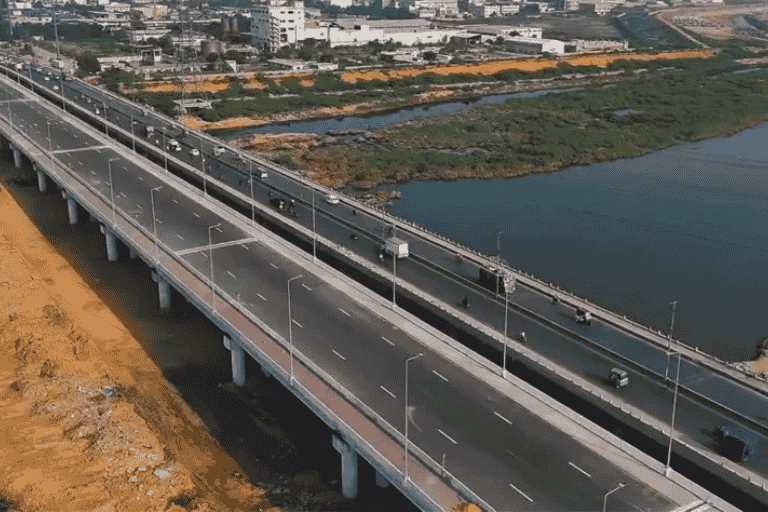Introduction
The Senator Taj Haider Bridge, opened to the public in late October 2025, is one of Karachi’s latest transport projects designed to ease congestion, improve connectivity to industrial areas and become a key section of the Yellow Line Bus Rapid Transit (BRT) corridor. Named after the distinguished late senator and intellectual Taj Haider, the bridge sits adjacent to Qayyumabad Chowrangi and is intended to provide faster, safer travel for commuters and freight moving between Korangi Industrial Area and surrounding neighbourhoods.
A practical, phased opening
The Sindh transport authorities announced that the bridge will operate one-way during its first ten days of public use as traffic patterns are tested and minor finishing works continue — after which two-way traffic is to be restored. This phased approach is typical for large urban links so that engineers and traffic managers can monitor safety, signage and traffic discipline before full operations.
Design highlights: lanes, cycling track and future expansion
The Taj Haider Bridge was built with dedicated lanes for public transport and a separate cycling track, reflecting a multimodal design philosophy aimed at improving safety and encouraging non-motorized transport. Officials say another parallel bridge is under construction that will together provide a total of eight lanes on this corridor — a configuration intended to segregate BRT, general traffic and active-transport lanes for smoother flow. These design choices are framed as part of a broader effort to modernize Karachi’s road network and integrate it with public transit upgrades.
Role in the Yellow Line BRT and wider public transport plans
The Taj Haider Bridge is a strategic component of the Yellow Line BRT project, which the provincial government has been fast-tracking to expand rapid bus travel across Karachi. Officials have said Yellow Line buses — including a fleet of electric buses planned under the People’s Green Transport Project — will use the dedicated lanes, improving journey times and offering a reliable alternative to private vehicles. The Yellow Line’s integration with new bridges and link roads aims to reduce bottlenecks between residential and industrial areas, particularly the Korangi Industrial Area, which currently generates heavy commuter and goods traffic.
Impact on local commuters and industry
Korangi and nearby localities have long faced connectivity issues; the new bridge shortens routes and bypasses local chokepoints, promising measurable reductions in travel time for workers, delivery vehicles and public buses. Transport officials say that once the adjacent infrastructure (including the final phase of Shahrah-e-Bhutto and connecting link roads) is complete, traffic pressure on nearby arterials and access routes to the M-9 motorway will ease significantly — benefits that will extend to freight movement and emergency access besides daily commuting.
Jam Sadiq Bridge replacement and road standards
The government has confirmed that the older Jam Sadiq Bridge — located nearby — will be demolished and replaced with a larger, modern structure built to current technical and safety standards, further expanding capacity on this corridor. Replacing aging structures with new, code-compliant bridges is intended to reduce maintenance costs, improve load capacities for heavy vehicles, and eliminate structural and geometric constraints that previously slowed traffic.
Safety, cycling and multimodal benefits
The provision of a separate cycling track on the Taj Haider Bridge is notable in Karachi’s context — cycling infrastructure in the city has historically been scarce. While the uptake of cycling will depend on feeder networks, last-mile connectivity and safety conditions, the inclusion of a dedicated track signals policy intent to support alternative mobility modes. Likewise, dedicated BRT lanes will reduce bus-car conflicts and should improve both reliability for passengers and safety for vulnerable road users.
Environmental and fleet modernization links
The Sindh government has publicly committed to expanding electric public transport as part of the People’s Green Transport Project; earlier announcements confirm the province plans to introduce 500 electric buses across Karachi and Hyderabad in phases. The Taj Haider Bridge and Yellow Line BRT are being presented within this larger package of interventions designed to lower emissions, modernize fleet operations, and provide cleaner, more comfortable public transport options.
Implementation challenges and what to watch
Large urban projects in Karachi face several recurring challenges: completing feeder roads and junction upgrades on time, ensuring consistent lane discipline (especially at merge points), integrating ticketing and depot operations for BRT, and maintaining infrastructure amid heavy use. For the Taj Haider Bridge to deliver the promised travel time savings, authorities must synchronize bridge operations with the remaining Shahrah-e-Bhutto completion works and connecting link roads, which have been targeted for finalization by December 2025. Close coordination with national and provincial agencies, as well as clear public information campaigns, will be essential in the bridge’s first months of service.
Social and political context
Project statements from provincial leaders emphasize that the bridge is part of wider development goals for Karachi, framed as improving livelihoods, enabling easier access to jobs and healthcare, and demonstrating visible infrastructure delivery for citizens. Officials have also used the opening to promote related social initiatives — such as new bus routes, the Pink Scooty scheme for women, and job-portal linkages — underlining that transport investments are being positioned as part of an integrated urban development agenda.
Conclusion
The Senator Taj Haider Bridge is more than a local crossing: it is a deliberate, visible step toward an integrated BRT corridor and multimodal transport network in Karachi. With dedicated BRT lanes, cycling infrastructure, and a commitment to electric buses and link-road upgrades, the bridge could measurably improve mobility for the industrial Korangi area and beyond — provided the adjoining projects and traffic management measures are completed and enforced on schedule. As Karachi transitions to more technology-led transport solutions, the Taj Haider Bridge will be an important early test of whether infrastructure upgrades translate into day-to-day benefits for commuters and the city’s economy

